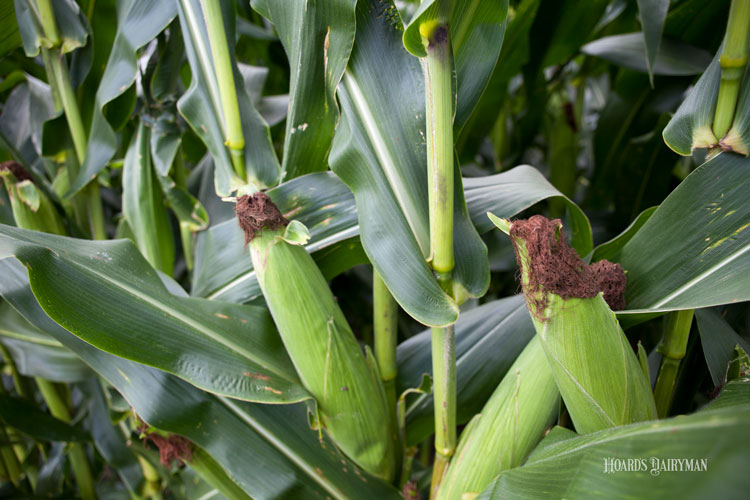
With the 2020 turmoil, I sense this time of the year brings excitement and a sense of purpose for many. We are now, as a nation, fully into the corn silage phase of Harvest 2020. This year we should be able to largely control the outcome. Being in control should be both desirable and comforting.
Many farms this year should recognize strong yields, which afford us better harvest options relative to poor growing years. While yield appears strong, quality may be less than ideal, in my opinion, following adequate heat units and moisture in the front half of the year. However, we can influence several aspects of harvest to maximize silage quality.
Start by getting out and scouting your fields with your agronomist. Look for ear and stalk rot, or other plant health concerns, that may need to be addressed during harvest. Make sure to monitor both moisture and kernel maturity to time your harvest. Then, work through the following control points with your nutritionist and harvesting team to set out for a successful harvest.
Cut height matters
Whole-plant corn cut or chop height is a hot topic with many at the moment. For example, a recent Forage Flash published in Hay & Forage Grower discusses the options. Due to above average yields, assuming forage inventories are adequate, many are considering chopping their corn (10 inches higher than normal, or more).
University of Wisconsin-Madison’s Luiz Ferraretto, his students, and I have reviewed prior published work in this area. Based upon quality gains associated with a 10-plus inch increase in cut height, I’ve projected there could be over a pound per cow milk response to high-cut silage. This quality gain needs to be balanced against yield losses, but we have the data available to project cash flow. Ask your nutritionist for his or her thoughts on this topic. Consider chopping a few loads at different heights, then take samples for forage quality. Your nutritionist should then be able to run performance projections with these meaningful results from your farm and fields for cash flow projections.
Kernel processing score goal posts have moved
The corn silage kernel processing score (KPS) goal used to be 60 to 70 (percent of starch being smaller than 4.75 millimeters or mm; roughly the width of a .22-caliber bullet). However, today’s forage harvesters and progressive managers are achieving scores in the 75 to 80-plus range. For example, the 15% of KPS results through Rock River Laboratory for the 2019 crop were 78 or better!
Set your goals accordingly and monitor kernel processing during harvest. A float test (put a handful of silage in water, remove the floating stover, and look at the grain) can help, or work with your key industry partners or nutritionist to check KPS during harvest. Bear in mind that KPS improves with ensiling, so a 65 KPS at harvest will likely be 75 KPS after adequate ensiling. Set your goal to be at least 65 for freshly chopped corn.
Chop length depends
This question routinely comes through, with producers and custom harvesters wondering what the ideal cut or chop length is for dairy performance. The answer is not straight forward, though. The ideal length is diet and farm dependent. For example, with low forage and/or high corn silage diets, the particle length in corn silage is critical to rumen function and health. Whereas, with high forage and/or high haylage diets, corn silage cut length is not as important.
Complicating matters further, the chop length should be managed relative to whole-plant moisture and kernel maturity. With whole-plant chopped corn approaching 60% moisture and kernels likely being overly mature, the theoretical chop length should be set shorter than it would be for the same farm and diet at wetter and less mature conditions. Further yet, chop length can be affected by kernel processor aggressiveness. Monitor whole-plant chopped corn particle size with a Penn State particle size separator and consult with your nutritionist for your farm specific goal.
Chopping damaged fields
Unfortunately, there are heavily damaged fields in Iowa. There also may be wind or hail damaged fields elsewhere following recent storms. In Iowa, there are flattened fields, with either goosenecked or green-snapped plants. Work with your agronomist to understand the difference between these two situations.
With goosenecked corn plants, the crop is still alive and has a chance to recover and straighten up. Here, I’d advise letting the fields recover and upright. With green-snap or other catastrophic damage, such as severe hail, I recommend going out and chopping this corn as soon as possible. Dead or heavily damaged plants will begin to rot in the field. Don’t wait for moistures to drop. Chop this corn and manage a wetter than ideal but hygienically cleaner feed. When chopping, also have scouts safely walk fields before chopping and look for metal and blown debris. There are grain bins and other debris in many cornfields that warrant careful scouting. Also consider reaching out to grain farming neighbors, to gauge their interest in selling damaged corn acres for silage.








